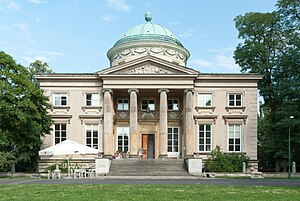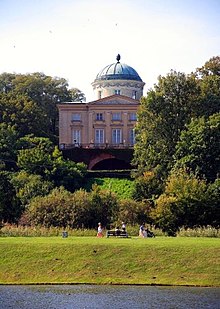Królikarnia Palace
| Królikarnia Palace | ||
|---|---|---|
| Creation time : | 1765 | |
| Castle type : | palace | |
| Conservation status: | Reconstructed | |
| Place: | Warsaw | |
| Geographical location | 52 ° 11 '20.4 " N , 21 ° 1' 42.5" E | |
|
|
||
The Królikarnia Palace (the common name is Królikarnia ), located on the bank of the Vistula in the Warsaw district of Mokotów , became the residence of Count Karol de Valérie-Thomatis , a chamberlain of the last Polish King Stanislaus II August , at the end of the 18th century Poniatowski , erected. Today there is a museum in the building at 113A Puławska Street. The palace is an outstanding example of classical architecture in Warsaw.
history
In 1778 Valérie-Thomatis acquired the land on which the rabbit hutch (Polish: Królikarnia ) of the Saxon-Polish King August II. Had previously been, from Princess Izabella Lubomirska , nee. Czartoryska. The terrain forms a tongue about 250 meters wide in the embankment, as it is surrounded on both sides by small valleys. The architect of the royal court in Warsaw, Domenico Merlini , was commissioned to build a residence on the site; Not only did he design the facility, he was also the site manager. First of all, farm buildings and a chicken house were built between 1780 and 1782. Then the kitchen house was built directly on the slope. It was built in a round shape and was modeled on the tomb of Caecilia Metella in Rome . The palace was built from 1782 to 1786 - also located directly on the edge of the Vistula embankment. It was connected to the kitchen house and a grotto below the east-facing terrace through underground passages. A brewery and an inn were operated in other buildings.
The palace building is a spacious villa in the classicism style on a square floor plan. The architect also used baroque elements. Columns are decorated with Corinthian capitals. In the middle of the building there is a round hall, which is crowned by a tambour with a final dome. Model here was in Vicenza situated Villa Capra of Andrea Palladio . In addition, a park was created around the individual elements of the ensemble. It is assumed that Valérie-Thomatis wanted to sell the finished ensemble to the king, who - according to an anecdote - lost a shoe in the rain-soaked ground during an appointment and was annoyed no longer interested in the object. It is disputed whether the king later got to know and met lovers who were regularly brought to him by Valérie-Thomatis.
Valérie-Thomatis opened the park to the public and so the “Królikarnia” became a popular destination for Warsaw society.
“ ... We want to list the most visited places of pleasure: a) Królikarnia (Rabbit Garden) 1/4 mile from Warsaw, an animal garden with a palace in modern taste, from whose beautiful domed roof one has the most charming view of the area, an English garden and a picture gallery, which is the most beautiful in Poland ... "
From June 10 to 14, 1794, Tadeusz Kościuszko took quarters in the palace during the occupation of Warsaw as part of the Kościuszko uprising . The building was significantly damaged in the ensuing skirmishes between Polish and Russian troops, Valérie-Thomatis himself was injured by a grape splinter. After his death the property fell to his children, from whom Prince Michał Radziwiłł bought it in 1816. The prince, an art collector, housed part of his painting and book collections in the palace.
The Królikarnia also played a strategically important role in the November uprising in Poland .
In 1849 Ksawery Pusłowski bought the plant; until the outbreak of the Second World War it remained in the possession of his descendants. Its important collections of tapestries , bronzes, marble statues, books and paintings were destroyed in a fire in the Królikarnia in 1879. Under Józef Huss , the palace was rebuilt true to the original. The construction work was completed in 1880 - a plaque in the hall commemorates this date. In 1889, the palace became the property of Countess Marta Krasińska.
During the bombing of Warsaw during the September campaign , the palace was again badly damaged in 1939. During the Warsaw Uprising , members of the Polish Home Army fought here against Wehrmacht troops . The parks and the round kitchen building that were still in existence until then were destroyed. The reconstruction took place according to a design by Jan Bieńkowski in the 1960s and was supported by the Polish People's Army . In 1965 the building was completed; apart from the round hall, however, the interior was not faithfully rebuilt. The Xawery Dunikowski Museum , located here and belonging to the National Museum in Warsaw, opened on January 26, 1965 . The reconstruction and use of the building as an exhibition space and residence for Dunikowski had already been decided in 1948, but the work could only be completed after the artist's death.
Today, concerts, film and other cultural events are held in the Królikarnia in addition to the permanent indoor and outdoor exhibitions.
Królikarnia Palace from the southwest, watercolor by Zygmunt Vogel , 1791
References and comments
- ↑ Count Karol de Valérie-Thomatis (more precisely: Karol de Thomatis Count von Valérie) was chamberlain and from 1765 to 1767 the director of the royal theater of Stanislaus II August Poniatowski. He came from Milan and is described as a typical careerist at the king's court who had good connections with the Russian court. Valérie-Thomatis was a passionate card player - partly according to Information on the notice at the entrance to the park.
- ↑ according to Janusz Durko, album Warszawski / Warsaw album. The image of the city according to the collections in the Historical Museum of the Capital City of Warsaw , German-Polish edition, Agencja Reklamowo-Wydawnicza A. Grzegorczyk, ISBN 83-86902-73-6 , Warsaw 2000, p. 210.
- ↑ Here rabbits were raised for later hunting.
- ↑ according to Czapelski, Historia sztuki nowoczesnej polskiej (architektura), will palladiańskie. Pałac Królikarnia , [1] at Chomikuj.pl from December 6, 2003 (Polish).
- ↑ according to Mary Lindemann, Liaisons dangereuses. Sex, law, and diplomacy in the age of Frederick the Great , p. 239 , JHU Press, ISBN 08-01883-17-2 , Maryland, Baltimore 2006.
- ^ Paul Anton Possart, Józef Łukaszewicz, Mułkowski. The Kingdom of Poland and the Free State of Krakow, Warsaw District , p.119 , Literatur-Comptoir, Stuttgart 1840.
- ↑ Michał Hieronim Radziwiłł (1744–1831) was Wojewode von Wilno , owner of Nieborów and Arkadia and an important art collector.
- ↑ according to Friedrich von Smitt, History of the Polish Uprising and War in the Years 1830 and 1831 , III. Teil, pp. 390, 401, 429, 435, 578 and 580 , Duncker and Humblot, Berlin 1848.
- ↑ according to Information Królikarnia ( Memento of the original from June 2, 2011 in the Internet Archive ) Info: The archive link was automatically inserted and not yet checked. Please check the original and archive link according to the instructions and then remove this notice. at Warsawtour.pl (Polish).
See also
literature
- Tadeusz S. Jaroszewski, Palaces and Residences in Warsaw , Interpress Publishing, ISBN 83-223-2049-3 , Warsaw 1985, p. 71 ff.
Web links
- Museum website







